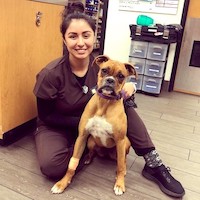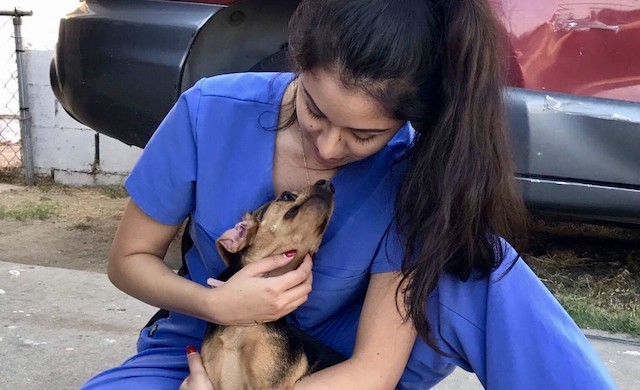
Two Interests Converge to Create a Unique Specialty
09/20/2019 06:00AM | 3113 viewsBy Kim Perez
In high school, Joana Casillas Lopez followed her instincts to pursue two different interests that today converge to give her a unique combination of skills – a soon-to-be veterinary technician who also knows American Sign Language.
When she was 15 years old, Joana Casillas Lopez met a woman who brought animals to her school – dogs, birds, even lizards – to introduce the students to opportunities for working with animals. Casillas Lopez was intrigued. The woman worked at an animal shelter that happened to be nearby, so Casillas Lopez started volunteering after school. She fell in love with the work, first helping in the office, and little by little, helping care for the animals.
“At that stage, these animals would not have survived without someone taking them in,” she said. “After seeing them get so much better – I decided I wanted to be just like her. She told me to go for it.”
Also while in high school, Casillas Lopez, who was already fluent in Spanish and English, started learning American Sign Language (ASL). After graduating from high school, she studied ASL and even started working to become an interpreter. But during a study session, a friend asked her what she planned to do after graduation, and her first thought was that she wanted to return to animals.
She realized in that moment: “I’m going to become a veterinary technician and do exactly what I’ve always wanted to do.”
She enrolled in Pima Medical Institute, which offers an accelerated 14-month program for veterinary technicians. The main campus is Arizona but there’s also one near her in Chula Vista, California. She will graduate in late 2019 and take the statewide licensing test to become a Registered Veterinary Technician.
She joined Banfield, the nation’s largest general veterinary practice, in 2015 with an externship as part of her studies, and then was hired as a client service coordinator for Banfield’s hospital in Chula Vista.
“As a client services coordinator,I’m often the first and last person clients see when they visit our hospital. You need to be able to communicate with clients who speak different languages and have different cultures and mindsets, so you can understand where they’re coming from and offer the right counsel. Some people don’t understand why they should invest in preventive care like flea/tick preventives or spay/neuter, and our veterinary teams partner with clients to earn trust and offer the right education.”
She said her years of listening to such a variety of clients has helped her grow as a person. “I feel like I’ve changed in a way. I was very shy. This has helped me become less insecure. I believe in myself a lot more now.”
Thanks to her pursuit of her two distinct passions – pets and language – she is better able to give clients a level of understanding and connection that builds trust.
She acknowledges that language can be a struggle for many people. She grew up in a Mexican household – her mom was from Guadalajara and her dad was from Tijuana. Her first language was Spanish, and she learned English at age four. But she wants to make sure people don’t let things like language barriers hold them back.
“Don’t let anybody tell you something is impossible,” she said. “Just go along with your path and your heart and prove them wrong. You can definitely do it. It may take time, but you’ll finish it. I really encourage people who don’t have mindset of tying to jump into something that’s uncomfortable, just try it. If you fail then just get back and do it again.”






Post your Comment
Please login or sign up to comment
Comments